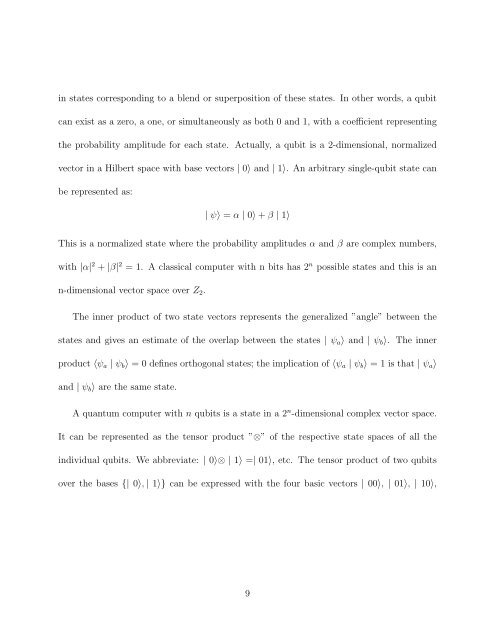t b a b a
t b a b a
t b a b a
Create successful ePaper yourself
Turn your PDF publications into a flip-book with our unique Google optimized e-Paper software.
in states corresponding to a blend or superposition of these states. In other words, a qubit<br />
can exist as a zero, a one, or simultaneously as both 0 and 1, with a coefficient representing<br />
the probability amplitude for each state. Actually, a qubit is a 2-dimensional, normalized<br />
vector in a Hilbert space with base vectors | 0〉 and | 1〉. An arbitrary single-qubit state can<br />
be represented as:<br />
| ψ〉 = α | 0〉 + β | 1〉<br />
This is a normalized state where the probability amplitudes α and β are complex numbers,<br />
with |α| 2 + |β| 2 = 1. A classical computer with n bits has 2 n possible states and this is an<br />
n-dimensional vector space over Z2.<br />
The inner product of two state vectors represents the generalized ”angle” between the<br />
states and gives an estimate of the overlap between the states | ψa〉 and | ψb〉. The inner<br />
product 〈ψa | ψb〉 = 0 defines orthogonal states; the implication of 〈ψa | ψb〉 = 1 is that | ψa〉<br />
and | ψb〉 are the same state.<br />
A quantum computer with n qubits is a state in a 2 n -dimensional complex vector space.<br />
It can be represented as the tensor product ”⊗” of the respective state spaces of all the<br />
individual qubits. We abbreviate: | 0〉⊗ | 1〉 =| 01〉, etc. The tensor product of two qubits<br />
over the bases {| 0〉, | 1〉} can be expressed with the four basic vectors | 00〉, | 01〉, | 10〉,<br />
9

















